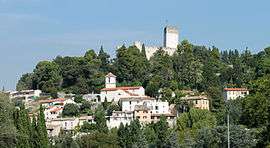Villeneuve-Loubet
Villeneuve-Loubet (pronounced [vilnœv lube]),Occitan: Vilanuòva e Lo Lobet; Italian:Villanova Lobetto) is a commune in the Alpes-Maritimes department in the Provence-Alpes-Côte d'Azur region in southeastern France. It lies between Cagnes-sur-Mer and Antibes, at the mouth of the river Loup.
Villeneuve-Loubet | |
|---|---|
 The village overlooked by the Château de Villeneuve-Loubet | |
.svg.png) Coat of arms | |
Location of Villeneuve-Loubet 
| |
 Villeneuve-Loubet  Villeneuve-Loubet | |
| Coordinates: 43°39′32″N 7°07′20″E | |
| Country | France |
| Region | Provence-Alpes-Côte d'Azur |
| Department | Alpes-Maritimes |
| Arrondissement | Grasse |
| Canton | Villeneuve-Loubet |
| Intercommunality | CA Sophia Antipolis |
| Government | |
| • Mayor (2008–2014) | Richard Camou |
| Area 1 | 19.60 km2 (7.57 sq mi) |
| Population (2017-01-01)[1] | 15,241 |
| • Density | 780/km2 (2,000/sq mi) |
| Time zone | UTC+01:00 (CET) |
| • Summer (DST) | UTC+02:00 (CEST) |
| INSEE/Postal code | 06161 /06270 |
| Elevation | 0–213 m (0–699 ft) |
| 1 French Land Register data, which excludes lakes, ponds, glaciers > 1 km2 (0.386 sq mi or 247 acres) and river estuaries. | |
It was created by the joining two old villages: the old village of Villeneuve inland and the village of Loubet on the shore of the Mediterranean Sea. Its inhabitants are called Villeneuvois.
Economy
It is at the same time a seaside resort and part of the technopole of Sophia Antipolis, many companies of the tertiary sector being installed in the city.
Culture
Villeneuve-Loubet is the birthplace of the famous 19th century provençal chef, restaurateur, and culinary writer Auguste Escoffier, the author of the Guide Culinaire and the founder of French haute cuisine. Villeneuve-Loubet was also, from 1920 onwards, the home of Maréchal Philippe Pétain (1856–1951), the "Hero of Verdun" in World War I and chief of state of the Nazi-collaborationist État Français, commonly known as Vichy France, in World War II.
The writer and historian Jules Bertaut (1877–1959) died in Villeneuve-Loubet.
Marshall Philippe Pétain purchased a house called L'Ermitage in Villeneuve-Loubet circa 1920.[2]
Villeneuve-Loubet was also the site of a battle in World War II when it was liberated by the First Special Service Force on August 26, 1944. The tower of the castle was damaged by a shell fired by the US Navy, and dozens of soldiers from both sides were killed or wounded. In 2006, the bodies of fourteen Germans who were killed during the fighting were discovered in a mass grave near the town by a local medical student.[3]
Saint Marc Church (15th century): The stained glass was created by the artist painter Pier Lecolas in 2006.
Population
| Historical population | ||
|---|---|---|
| Year | Pop. | ±% |
| 1962 | 2,769 | — |
| 1968 | 3,865 | +39.6% |
| 1975 | 6,001 | +55.3% |
| 1982 | 8,083 | +34.7% |
| 1990 | 11,539 | +42.8% |
| 1999 | 12,935 | +12.1% |
| 2010 | 15,020 | +16.1% |
References
- "Populations légales 2017". INSEE. Retrieved 6 January 2020.
- Griffiths, Richard (1970). Marshal Petain. London, U.K.: Constable & Company. p. 91. ISBN 9780094738102. OCLC 832329867.
On 14 September 1920, he got married, at the age of sixty-four. He and his future wife had already been house-hunting, and had found a country house in the South of France, 'L'Ermitage' at Villeneuve-Loubet in the department of Alpes-Maritimes.
- Jean-Loup Gassend (2014). Autopsy of a Battle: the Allied Liberation of the French Riviera August-September 1944. Schiffer Publications. ISBN 9780764345807.
| Wikimedia Commons has media related to Villeneuve-Loubet. |